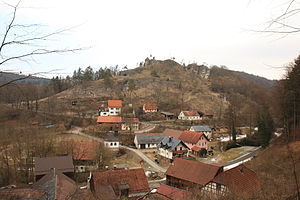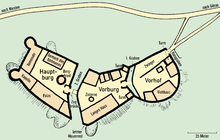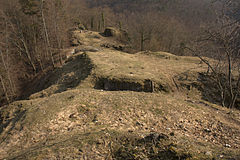Niesten Castle
| Niesten Castle | ||
|---|---|---|
|
Niesten Castle - view of the castle hill from the southwest |
||
| Creation time : | Early 11th century (secured: before 1128) | |
| Castle type : | Höhenburg, spur location | |
| Conservation status: | Trenches, ramparts and small remains of walls and building traces on rocks | |
| Standing position : | Initially lower nobility (Niestener) , then high nobility ( Andechs-Meranier ) , later again lower nobility ( Modschiedler ) |
|
| Construction: | Humpback cuboid | |
| Place: | Niesten ( Weismain ) | |
| Geographical location | 50 ° 4 '19.1 " N , 11 ° 15' 51" E | |
| Height: | 425 m above sea level NN | |
|
|
||
The castle Niesten was an important fortress in the Middle Ages in the area of the present town Weismain , district Niesten, in the district of Lichtenfels in Upper Franconia . It secured a trade route that was important at the time and was long considered impregnable. The castle, which is still in ruins in a few remains of the wall, is freely accessible. The Castle Hill and the castle site itself serve as a goat - and sheep - pasture . The small Eselsloch cave is located directly on the way to the castle .
Geographical location
The former spur castle stood on a prominent, steeply sloping elevation made of sponge limestone , the western side summit of the 489.6 m high Kahlberg . The mountain is the highest point of an approx. 1.7 km long ridge, which begins at Görau in the southeast and ends at Niestener Burgsporn in the west. Like the surrounding hills and ridges, the Kahlberg ridge belongs to the north-eastern Franconian Jura in the Altenkunstadt-Buchauer Alb foreland . In the southwest of the mountain spur is the small village of Niesten, today a district of Weismain. It is located in the so-called Zillertal, a side valley of the Krassach Valley , which in turn is a side valley of the Weismaintal south of the Main .
The rock below the castle ruins has been designated as an important geotope by the Bavarian State Office for the Environment (geotope number: 478R010).
history
Establishment
At the turn of the first to the second millennium, the capital Weismain was still relatively insignificant and was rarely mentioned in documents and other documents. Due to its geographically important location on the Bamberg - Scheßlitz - Weismain road, which was important at that time , the castle may have had an important protective function during the development of the state in this region by the margraves of Schweinfurt . Until the male lineage died out in 1057, the area around the Weismain valley funnel belonged to the territory of the margraves of Schweinfurt. It is therefore assumed that the castle was built around the year 1000 on behalf of Heinrich von Schweinfurt . However, this cannot be clearly proven. A pre-Christian hill fort could have stood in the same place before .
Another theory says that Otto von Bamberg had the castle built during his tenure as Bamberg's bishop at the beginning of the twelfth century. It would have been around 100 years younger and owned by the Bamberg bishops from the start. If one assumes that Heinrich von Schweinfurt was the builder, the castle came into the possession of one of his daughters after his death and only then, however, also around 1100, came into Bamberg possession. In both cases, however, the castle was given to the noble free von Niesten family as a castle hat without any further intermediate owners. Your name came about when the castle hat was commissioned.
The first documented mention of the castle was in 1127 or 1128 as "municionem Nienstein" on the occasion of a futile siege by a Friedrich, probably the brother of the Hohenstaufen king Konrad III. , who at that time oppressed the diocese of Bamberg. This event was reported in a letter from Abbot Wignand von Theres to Bishop Otto I, which is seen as evidence that Niesten was in Bamberg's possession from this point at the latest. Exactly when the castle came into the possession of the Bamberg bishops within the period of around 28 years cannot be determined from the available sources.
Rule of the Niestener
In a document from Michelsberg Monastery in 1142, "Otto von Niesten" was named as the lord of the castle, who had received the castle as a fief from Bishop Egilbert in the same year . Otto's brother, "Fridericus de Niste" (Friedrich von Niesten) was mentioned as the last member of the independent sex of the Free von Niesten in 1186 or 1188. The sex was presumably closely related to the noble free von Leutenbach (from Leutenbach (Upper Franconia) ), appeared for the last time in 1188 when selling various possessions and then disappeared from the documents. The line probably died out when Otto and Friedrich participated in the Third Crusade and never returned. Since the castle was only given as a fief, it fell back to Bamberg after the Niesten family died out.
Rule of the Andechs-Meranians
Around 1190, the Bamberg Bishop Otto VI. von Andechs the castle as an episcopal fiefdom to his nephew Berthold IV of Andechs and thus to the dukes of Andechs-Meranien . They had the castle administered by Ministeriale . After the death of Berthold in 1204 the castle passed to his son I. Otto over. From the year 1207 a "Diepoldus de Nisten" in Meran services has come down to us; like all ministerials of the castle this one called himself von Niesten , but was not related to the original sex of those von Niesten. In 1234, when Otto died, the castle passed to his son Otto II von Andechs, Duke of Merania and Count Palatine of Burgundy . Lonely, withdrawn and suffering from a serious illness, he died on June 19, 1248 at the age of 30 at Niesten Castle, leaving no heirs. Occasionally there was a rumor that Otto had been murdered, but such rumors were frequent in the case of unexpected deaths of nobles. In this case in particular, the rumor is to be regarded as untrue or as a legend .
With Otto's death, the house of the Andechs-Meranians , at that time one of the most important German ruling dynasties, died out. With this, an important power factor in the south of the empire disappeared, which had far-reaching consequences for the sovereign-state order of this area. After Otto II's death, his truchess Willebrand von Plassenberg took over the administrative rule of the castle until the testamentary heirs, Otto's sisters and their husbands ( Beatrix von Andechs-Meranien with Hermann II. Of Orlamünde , Margarete von Andechs-Meranien with Friedrich I. von Truhendingen and Elisabeth von Andechs-Meranien with Friedrich III. von Nürnberg ) had agreed on ownership. The then Bamberg Bishop Heinrich I von Bilversheim wanted to bring the castle back into the possession of the diocese. In the next twelve years armed conflicts ensued between him and his allies on the one hand and the rightful heirs on the other, which did not end until 1254.
The following year, on February 10, 1255, Heinrich I von Bilversheim received the castle of Willebrand von Plassenberg back for the then large amount of compensation of 250 marks; Otto's sisters and brothers-in-law were defeated in the War of the Merano Succession. Under Bilversheim's successor, Berthold von Leiningen , there were again minor battles with Hermann II of Orlamünde from 1257 . The rightful possession of the castle was finally granted to the Bamberg monastery through an arbitration ruling, the Langenstädter Spruchfrieden, on December 14, 1260 in Langenstadt near Kulmbach . The death of Otto I had far-reaching consequences not only for the ownership of the castle, but also for the entire Upper Franconian region, as it brought about changes in the distribution of power in this region.
Rule of the Modschiedler and the Weismainer Vogts
At the beginning of the 14th century, the castle belonged to the Franconian noble family of Modschiedler and was either under their rule or in the subsequent period, but still in the late 14th century, the official seat of the Weismainer Vogts , who was under the Bamberg bishops. From the year 1401 at the latest, from which a written record has been preserved, the area under the castle was officially called "Amt Niesten". In 1499 the complex was greatly enlarged by expanding the outer bailey, partly in the half-timbered style.
In the following centuries the castle was fiercely contested over and over again. The Peasants' War left extensive damage in 1525, which is why the official seat was temporarily relocated to Weismain. The castle was rebuilt around 1528, after which the castle became the official seat again. During the Second Margrave War , the castle was destroyed again in 1553 by a fire. After the rebuilding, the official seat, which was meanwhile again in Weismain, was moved back to the castle. During the Thirty Years' War the castle was conquered on March 12, 1633 by Bernhard von Sachsen-Weimar on behalf of the Swedish crown. The war in the years 1630–1635 once again caused great damage to the castle. In 1691, the Bamberg government decided the final move of the bailiff's official seat to Weismain in the younger Neydeckerhaus, today's town hall.
Decline

After the last Vogt moved to Weismain in 1710, the castle stood empty and the complex slowly decayed. In 1742 the plans to have the castle renovated by Justus Heinrich Dientzenhofer and Johann Jakob Michael Küchel were finally rejected. In a storm on January 28, 1747, the castle, which had now become dilapidated, was badly damaged. The roof structure was lifted from its position and pushed one meter to the south, onto the southern curtain wall, which was split by the great weight.
The residents below the castle felt threatened by a possible collapse of the wall, so that the rest of the roof structure was removed on May 19, 1747 by order of the then Bamberg Bishop Johann Philipp Anton von und zu Frankenstein . The plan was to leave the lower, roughly five-meter-high stone floor standing, but because of their extraordinary quality, the stones were removed and, like parts of the entablature, brought to the Weismainer Kastenhof, so they remained in the hands of the authorities. Inferior material was offered to the population for sale, but some of the building material was stolen. Material from the castle was used in 1751 to build the stable in the Weismainer Kastenhof. The keep was preserved for the time being, as the stones were sufficient; a remainder of it was used for the construction of the mills in Niesten and Krassach and the Kreuzkapelle in Weismain. On August 18, 1795, the Niesten community acquired the ruins.
Around 1830 there were repeated initiatives to save the castle, but in 1872 the Niesten community had the keep and other remains of the wall removed. The last major remains collapsed in 1882.
description
The plant consisted of two parts, a high altitude main castle with a 24-meter high castle keep , a bower , a great hall , an office building and the St. Leonhard's Chapel . as the older, western part of the castle. The outer bailey, which was added in the 14th century, was separated by a moat and had three smaller towers, a stable , a kennel and a "long house". In total, the castle complex had three moats and three gatehouses . The building material was non-local sandstone . Today only a remnant of the wall made of humpback ashlar remains . It is located between two rocks and belonged to the Long House of the outer bailey.
literature
- Daniel Burger : The state fortresses of the Hohenzollern in Franconia and Brandenburg in the Renaissance era. Beck publishing house, 2000.
- Ingrid Burger-Segl: Archaeological forays in Meranierland am Obermain , Upper Franconia District, Bayreuth 2006, ISBN 3-9804971-7-8 , pp. 36–42, pp. 125–130
- Alois Dechant, Gerhard W. Peetz: hiking guide Weismain . Marie Link Verlag, Kronach, 2010
- Bernhard Dietz: History of Niesten Castle near Weismain , Niesten near Weismain, Staeffler, 1931
- Günter Dippold (Ed.): Weismain - A Franconian town on the northern Jura 1. Dechant Bau GmbH, Weismain 2011, ISBN 978-3-9814302-0-2
- Andreas Dück: The Meranians at Niesten Castle and in Weismain . In: History of the House of Andechs am Obermain (Karl Bosl), Lichtenfels 1963
- Norbert Fiedler: Niesten - Castle of the Meranians . In: Local supplement to the official school gazette of the administrative district of Upper Franconia # 137, Bayreuth 1987, length: 42 pages
- Society for Franconian History: The Andechs . In: Journal for Bavarian State History, Volume 63, Issue 3, Beck 2000, u. a. P. 737, 781, 168 Limited preview in Google Book search
- Historical association Bamberg (ed.): Weismain and the AndechsMeranier . In: Report - Volume 136, Kommissionsverlag Buchner, 2000, pp. 33–40 Restricted preview in the Google book search
- Friedrich Karl Hohmann: Days in the Wind: A Franconian Castle Fate , BoD, Norderstedt 2008, ISBN 978-3-8370-2414-2 , pp. 103–117 Limited preview in Google book search
- FW Krahe: Castles of the German Middle Ages , Würzburg, 1998, ISBN 3-86047-219-4 , p. 440
- Hellmut Kunstmann : Man and Castle - Castle studies at East Franconian fortifications , Commission publishing house Schöningh, Paderborn 1967, a. a. Pp. 121, 162, 168 - Limited preview in Google Book search
- Fritz Mahnke: Palaces and castles in the vicinity of the Franconian Crown, 2nd volume . Druck- und Verlagsanstalt Neue Presse GmbH, Coburg 1978, pp. 179-185
- Willy Plank: End of an early medieval ducal dynasty - the Meranians in Franconia at Niesten Castle . In: CHW - Jahrbuch der Geschichte am Obermain, Volume 1 (1951, reprint 1978), pp. 15-18
- Bernhard Thum: Topoführer Frankenjura , Thum, Freising 2010, ISBN 3-932064-03-8 , pp. 956-958
- Gustav Voit, Walter Rüfer: A castle tour through Franconian Switzerland . Verlag Palm & Enke, Erlangen 1984, ISBN 3-7896-0064-4 , ( Franconian Switzerland - Landscape and Culture 2).
- Ingrid Weiskopf (Ed.) (Die Kultur-Macher e.V.): Burgkunstadt, Altenkunstadt, Weismain - Art and Culture - Worth knowing and interesting yesterday and today . Altenkunstadt 2000, no ISBN, pp. 29–31
Web links
- Langenstadter Spruch, December 14, 1260 - detailed description of the disputes over the castle in 1248 at historisches-lexikon-bayerns.de
- Niesten Castle at Obermaingeschichte.de
- Info sheet about the Burgberg and the Eselsloch at lfu.bayern.de (PDF; 184 kB)
- Historical reconstruction drawing
Individual evidence
- ↑ a b c d e f g h i j k Dippold (2011), pp. 123-136
- ↑ a b c d e f g h i j k l Niesten Castle , burgenregister.de, accessed on May 4, 2012
- ↑ a b c Geological walk with Dr. Friedrich Leitz ( Memento from February 6, 2013 in the web archive archive.today ), landkreis-blog.de
- ↑ a b c d e f Entry on Niesten Castle in the private database "Alle Burgen"., Accessed on September 12, 2015
- ↑ a b c Görau, Kahlberg and Niesten in the Bayern Viewer ( Memento of the original from March 4, 2016 in the Internet Archive ) Info: The archive link has been inserted automatically and has not yet been checked. Please check the original and archive link according to the instructions and then remove this notice. , geodaten.bayern.de, accessed on May 8, 2012
- ↑ Bavarian State Office for the Environment, Geotop Felsen below the castle ruins NE of Niesten (accessed on October 14, 2017).
- ↑ a b c d e f g h i j k l Dippold (2011), pp. 120–121
- ↑ a b Dietz (1931), p. 8f.
- ↑ a b c d e f g h i j k l m n o p q r s t u v Weiskopf (2000), p. 29f.
- ↑ a b c d e Fränk Alb , farnkraut-coburg.de, accessed on May 4, 2012
- ^ Society for Franconian History (2000), p. 737
- ↑ Historischer Verein Bamberg (2000), p. 36.
- ↑ a b c Hohmann (2008), pp. 109–114.
- ↑ Andechsische dual power in Franconia , mgl-obermaingeschichte.de, accessed 4 May 2011
- ↑ a b c d Langenstadter Spruch, December 14, 1260 , historisches-lexikon-bayerns.de, accessed on May 4, 2012
- ↑ a b Matthäus Merian : Topographia Franconiae, 1648, p. 101 f.
- ↑ Otto II. , Manfred-hiebl.de, accessed on May 4, 2012
- ↑ Plank (1978), pp. 15-18
- ^ A b Society for Franconian History (2000), p. 781
- ↑ Mention of the noble family of Modschiedler , modschiedler.de, accessed on April 7, 2011
- ↑ a b Dippold (2011), p. 145
- ↑ a b c d e f g h i j Dechant (2010), p. 64 f.
- ↑ Dechant (2010), p. 20





